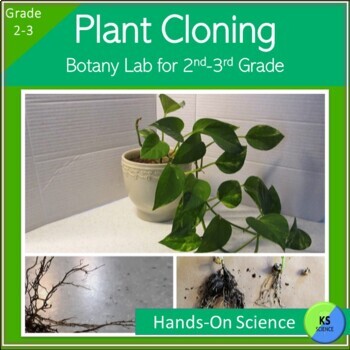Investigating Cloning Plants with Rooting Hormone
The typical method plants use to reproduce is through seeds. Reproducing with seeds allows for genetic variation.
There are other ways plants can reproduce. One way is by cloning. Cloning is when an entire organism is created from a piece of the original. They are genetically identical.
Typically the leaves, stems, or splitting from the original plant is used. At the end of the cutting, there is a mass of non-specialized cells called a callus. The callus, with the help of the correct hormone, is capable of growing into whatever cells are needed. It is amazing to think a leaf can begin growing roots and stems to produce new plants. It is a great way to get a new houseplant without spending money.
Some plants work better than others. Recommended plants are begonia, coleus, geranium, ivy, and philodendron. In the classroom, you can easily clone by using the stem with several leaves attached.
When cloning plants it is best to use rooting hormone. Plants contain many different kinds of hormones. Hormones are chemicals produced by the plant that control plant growth. Hormones send a signal telling the plant cells what to do. One important hormone is called auxin. Auxins control many functions in plants. They are created in the apical meristem. The apical meristem is located at the stem and root tips. One function of auxins is to help initiate root growth. When cloning plants it is best to use rooting hormone (auxin) because it will increase the odds of growing a healthier plant. Root development should happen faster and the roots should be healthier.
The conditions of the room are important too. Make sure the room is warm. The plant cutting will be delicate so do not put it in direct sunlight where it can dry out. It will most likely take a month or more to get good root development. Be patient.
Lets' Get Cloning
Supplies
House Plant Cuttings
Water
Rooting Hormone
16 oz. Plastic Bottles
Warm (Not too sunny.) Location
Permanent Marker
Ruler
Procedures
1. Cut a 15-inch stem from the plant. Cut the stem at a slight angle. Remove any lower leaves.
2. You should have 2-3 leaves or more at the top.
3. Fill the bottle or vase 3/4 full of water.
4. Dip the stem in the water. Then dip the stem into the rooting hormone only 1-2cm high. This will put rooting hormone on the end of the stem.
5. Place the stem in the bottle.
6. Place the bottle in a warm sunny location and observe for 1 month or more.
Tips
· Take weekly observations to keep track of any changes.· If the water evaporates below the roots make sure to add more. You do not need to add more hormones.
· If the water gets bad change the water. I would not add hormone and assume the plant had a good start with it.
· Many garden centers will have the correct types of plants.
Where do I get rooting hormone?
The large home improvement stores typically carry it. A local garden center can also help. It is also available online. This activity uses the powdered form.
SHOP THIS POST












